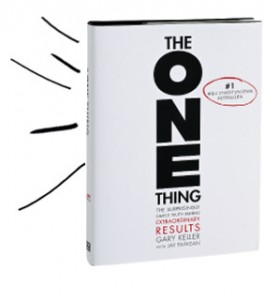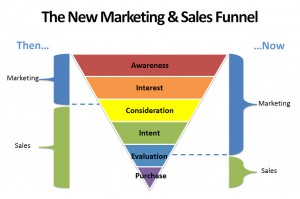Improve Sales Execution; The Power of One Thing
Multitasking is a lie that far too many people believe to be true. Scientific data proves multitasking is not as effective as focusing on one thing at a time and completing it before moving on to the next task. This is particularly true for salespeople as we have the reputation of; chasing shinny objects. When salespeople develop the discipline of focusing on one thing and seeing it to a close they meet and exceed their sales goals. In this post I will share a great new book I have been reading; The One Thing, the surprisingly simple truth behind extraordinary results by Gary Keller with Jay Papasan.
As I have shared before sales execution is often a common problem in sales teams. Senior leadership did their 2-3 day strategy planning, came away with the plan and rolled it out to the team. However in most cases, CEO’s find themselves frustrated six months into a new sales year when sales results are not achieving plan and upon investigation they find what I refer to as the great disconnect…sales is not executing the plan. Why does this occur and what can be done to insure sales execute the plan and achieve their sales goals?
Focus
As the authors of the book; The One Thing share we achieve more when we go small. It takes great discipline to ignore all the things we could do and focus on the thing we should do. The authors share six lies that stand in the way of our success;
- Everything matters equally
- Multitasking
- A disciplined life
- Will power is always on Will call
- A balanced life
- Big is Bad
I highly recommend you buy and read this book. You will find yourself highlighting each page and writing notes in the margins.
Having lead sales and marketing teams for over 30 years as well as coaching salespeople, one common area salespeople must get over to achieve sales plan and hit their goals is the myth of multitasking. They believe busyness drives business… and this is simply not true. What does drive sales results is focusing on serving the customer. However when you ask a salesperson a simple question; what did you do yesterday?…you will often hear;
- worked with frank in shipping to get my order out
- I helped Joanie in customer service with…
- I worked with engineering to quote the part #…
- I did my call report from my last trip
- I called and left messages with 6 current customers
- I did some research on a guy I have been trying to sell for over a year
- I worked with Lisa in accounting to get one of my accounts to pay their bill
- I booked my travel plans for the meeting we are having in two weeks
- I chased down the reasons why my order for …..did not ship on time as we promised
- I worked with scheduling to try to move up the delivery on my order for …..
- I did my expense report from the trip I did a month ago…
- I entered some updates into the CRM
- I sent email follow ups on order ship dates to some of my customers
- I read an article in our industry trade journal about how a number of our customers are moving to …..
So what is a sales manager to do? where do you start?
I am a big fan of four legged sales calls. This is where you travel with your salespeople and meet with current customers, potential customers and often past customers you have lost and are trying to win back. One of the things I am also doing is determining how focused the salesperson is. Yogi Berra said ; you can learn a lot by observing… and what I often observe that is also occurring in a salesperson’s day they may not be aware of includes;
- Multiple calls from their spouse or the person they are dating
- a text from one of their children or friends
- an email joke from a friend
- junk emails with links to content salespeople read
- LinkedIn updates on who visited their profile, who found a new job, and who may have endorsed them today
- Facebook updates
- Twitter updates
- Maybe Google + updates
- You tube videos they just have to watch
- Good articles from industry trade journals sent to their email
- Emails from customers needing help with quotes, order status updates, why an order did not ship
- Reading blogs about how to improve their sales performance
- Reading blogs and articles about their personal interests
* to make this even more of an interruption all of the above and more come through or cell phones.
You get the idea….salespeople today have a tremendous amount of distractions and can easily fall into the trap of believing being busy, having a great deal of activity , adds value. What adds value is bringing in and closing more profitable sales.
A great quote from the book; “ It’s not that we have too little time to do all the things we need to do, it’s that we feel we need to do too many tings in the time we have” – Gary Keller
What I really enjoyed about this book is how they blend in clinical research. Research shows workers are interrupted every 11 minutes and spend 30% of their day recovering from interruptions. We have an average of 4,000 thoughts a day flying in and out of our minds. We change a thought every 14 seconds so it’s easy to see how we fall into the trap of multitasking. But sales people who multitask get more done right? Wrong! Research shows;
- the more complex the task you switch from when distracted the less likely you are to go back to it
- chronic multi-tasker’s develop a distorted view of how long it takes to do things
- workers who multitask make more mistakes
- they have more stress
- multitasking makes us slower witted
The book goes on to share more statistics and if you are like me will quickly agree we have been sold a lie with regards to multitasking.
How do we break this cycle of poor sales execution as a result of the multitask lie? The authors give us a grounding question to ask ourselves and our people each day;
What is the one thing I can do such that by doing it everything else will be easier or even unnecessary?
Let that question soak in, seep deep into the marrow of your bones….
What is the one thing your salespeople can do that by doing it everything else will be easier or unnecessary?
What is the one thing you as the leader can do that by doing it everything else will be easier or unnecessary?
What is your to-do list for today? How many to-dos do you have today?
How can you boil that list to one thing that you will do today that will have the most impact because you focus on it and see it to completion?
I highly recommend the book; The One Thing as at first it will help you, your team, and your ability to drive extraordinarily results. The hidden benefits will also arise as you apply its wisdom to your personal life….your health, your marriage, spiritual life, your relationship with your children and so on. This book, like Ctrl Alt Delete will be a resource tool in my library for years to come.











